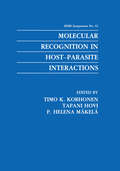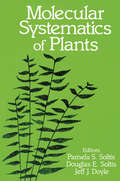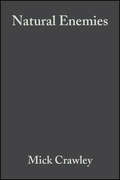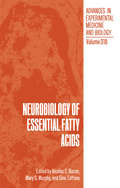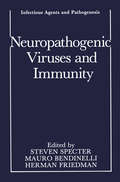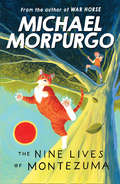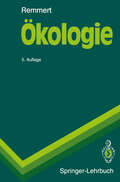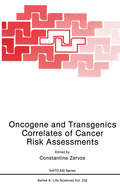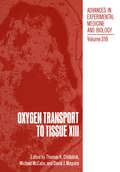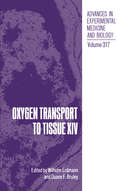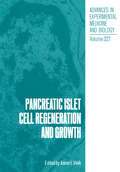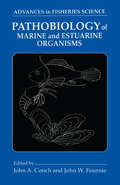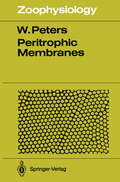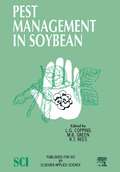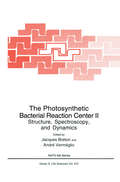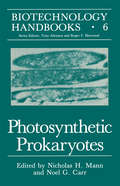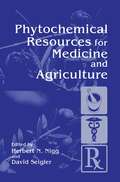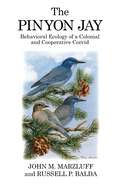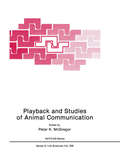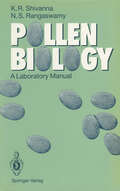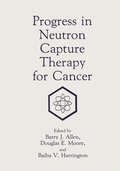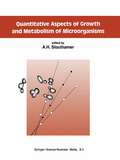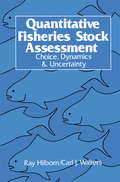- Table View
- List View
Molecular Recognition in Host-Parasite Interactions (F.E.M.S. Symposium Series #61)
by Timo K. Korhonen Tapani Hovi P. Helena MäkeläA very early step in microbial colonization and pathogenesis is that involving recog nition of the host by the microbe. In the final analysis such recognition is due to interaction between specific molecules on the two sides, without which host and microbe would ignore each other. It is therefore exciting to learn the rules that govern host-microbe interaction at to a large extent determines whether or not we are infected by the molecular level, which influenza virus, leishmanias, staphylococci and other pathogens. This book is a compendium of the addresses delivered at a symposium on molecular interaction at Porvoo, Finland in August 1991. Realizing that there are no a priori differ ences in receptor recognition in viruses, eukaryotic parasites and bacteria, we freely inter mingled these microbes at the symposium, and in this book. We found the interdisciplinary discussions and comparisons both educative and stimulating. Thus the book is divided into parts that focus on host cell receptors, on microbial recognition molecules and molecules that mediate microbial interaction with a host cell receptor and, briefly, on the molecular events that follow. Although many microbes and many cellular receptors are missing from the book -owing to the limited duration and size of the symposium -the articles presented here constitute an impressive body of examples of how initial host-microbe interaction can come about. We believe that as such the book is a useful and interesting overview of the mechanisms and principles involved in these interactions.
Molecular Systematics of Plants
by Pamela S. Soltis Douglas E. Soltis J. J. DoyleThe application of molecular techniques is rapidly transforming the study of plant systematics. The precision they offer enables researchers to classify plants that have not been subject to rigorous classification before and thus allows them to obtain a clearer picture of evolutionary relationships. Plant Molecular Systematics is arranged both conceptually and phylogenetically to accommodate the interests not only of general systematists, but also those of people interested in a particular plant family. The first part discusses molecular sequencing; the second reviews restriction site analysis and the sequencing of mitochondrial DNA. A third section details the analysis of ribosomal DNA and chloroplast DNA. The following section introduces model studies involving well-studied families such as the Onagraceae, Compositae and Leguminosae. The book concludes with a section addressing theoretical topics such as data analysis and the question of morphological vs. molecular data.
Natural Enemies: The Population Biology of Predators, Parasites and Diseases
by Michael J. CrawleyThis book is about disease and death. It is an ecologist's view of Darwin's vivid evocation of Nature, red in tooth and claw. An international team of authors examines broad patterns in the population biology of natural enemies, and addresses general questions about the role of natural enemies in the population dynamics and evolution of their prey. For instance, how do large natural enemies like wolves differ from small natural enemies like bacterial diseases in their effects on prey abundance? Is it better to chase after prey, or sit and wait for it to come to you? How should prey behave in order to minimize the risk of being eaten? The answers are all in this fascinating senior undergraduate/postgraduate text.
Natural Products as Antiviral Agents
by Chung K. Chu H. G. CutlerDuring the past fifty years, thousands of natural products have been isolated from plants, fungi, and bacteria. Apart from intense searches by pharmaceutical companies for medicinals and the concentrated effort mounted by the National Cancer Institute, many of these have not been tested in biological systems. The major reasons for this appear to be, at least, twofold. First, individual researchers looking for biologically active natural products will often isolate only small amounts of material sufficient to determine a structure and calculate the specific activity for their particular bioassay systems: insufficient funds preclude re-isolating the compound unless industrial potential is foreseen. Second, the difficulty with which original structures were proved prior to 1972. This required the isolation of relatively large quantities of a natural product and there followed extensive degradation, elemental analyses of the parent and its fragments, then synthesis, piece by piece, of the molecule. All this took time and energy. No wonder that when the structure was proved the chemist was enervated. And coupled to this was the fact that many chemists were not trained to test their materials in biological systems. In contrast, today a natural product can be isolated, its mass and molecular formula determined and, if there is some serendipity, crystals may be obtained for single crystal x-ray analysis. If conditions are near perfect, it is possible to isolate and identify a novel compound in a month.
Neurobiology of Essential Fatty Acids (Advances in Experimental Medicine and Biology #318)
by Nicolas G. Bazan Mary G. Murphy Gino ToffanoIt is increasingly evident that polyunsaturated fatty acids (PUFA), which in the past were often believed to be mere components of cellular membranes of neural tissue, are actually major determinants of the functional properties of neural cells and are intimately involved in brain disease processes. The two families of PUF A, which are derived from the essential polyenes, linoleic (18:26) and a-linolenic (18:33) acids, constitute a major proportion (-30%) of the total fatty acids esterified to brain phospholipids. Each family is distributed in membranes in a highly specific manner with respect to brain region, cell type, and position within each of the phosphoglycerides. Unlike their behavior in other organs, the PUF A components of brain turn over slowly and are relatively resistant to dietary modification. Their unique distribution and stability suggest that they play an important role in determining the functional properties of neural cells. However, until recently very little was known regarding the precise nature of their involvement.
Neuropathogenic Viruses and Immunity (Infectious Agents and Pathogenesis)
by Steven Specter Mauro Bendinelli Herman FriedmanThere has been a tremendous increase in interest in the neuropathogenicity of viruses during the past decade as we have come to recognize that the human immunodeficiency virus, which causes the acquired immunodeficiency syndrome (AIDS), can infect glial cells and cause neurological disease. Yet this increase has not been limited to AIDS but has extended to viruses that infect either or both the central and peripheral nervous systems. The changes examined here include both neurological and psychological diseases or syndromes. Moreover, the chapters in this volume review the interaction of the host immune system with the viruses examined and how such interactions may increase or decrease the neuropatho genicity of the viruses. Questions regarding viral neuropathogenesis include: (I) What is the mode of transmission of virus to the nervous system? (2) What types of cells are infected, and do they contain receptors for the virus? (3) What is the extent of damage that results from viral infection? (4) What are the immunologic mecha nisms by which damage is mediated or limited? Many of these questions remain unanswered, but this volume delves into efforts to provide some answers.
The Nine Lives of Montezuma
by Michael MorpurgoThe charming tales of one mischievous cat from War Horse author and former Children's Laureate Michael Morpurgo.
Oncogene and Transgenics Correlates of Cancer Risk Assessments (Nato Science Series A: #232)
by Constantine ZervosThe data, the information, and even the overarching knowledge necessary for risk assessments of economically important environmental carcinogens come, for the most part, from the applied biological disciplines, e. g. , toxicology, epidemiology, biostatistics, etc. The more fundamental biological disciplines, e. g. , biochemistry, cell biology, molecular biology, molecular genetics of cancer, etc. , have enormous but unrealized potential to improve current cancer risk assessment methods. The objective of this advanced research workshop ARW was to advance the state of the art of cancer risk assessment methods by identifying potential short and long term contributions to such methods from the more fundamental disciplines. Attention was paid to short and long term contributions from research advances in the biochemistry and physiology of oncogenes (oncogenes research) and in the construction and utilization of transgenic animals (transgenics research). In the last 20 years, researchers in the fundamental biological disciplines, i. e. , biochemists, geneticists, molecular and cell biologists, etc. , have, inter alia, advanced spectacularly our understanding of the nature of neoplastic diseases. Their phenomenal progress is the combined result of both advances and refinements of the techniques available to them and of new fundamental discoveries. Among the latter the most significant are the discoveries of oncogenes and of the feasibility of creating transgenic animals, i. e. , of transferring well defined and expressible genes from the cells of one species of organisms to the embryonic cells of another.
Oxygen Transport to Tissue XIII (Advances in Experimental Medicine and Biology #316)
by Thomas K. Goldstick Michael McCabe David J. MaguireThe International Societyon Oxygen Transport to Tissue (ISOTT) was founded in 1973 "to facilitate the exchange of scientific information among those interested in any aspect of the transport and/or utilization of oxygen in tissues". Its members span virtually all disciplines, extending from various branches of clinical medicine such as anesthesiology, ophthalmology and surgery through the basic medical sciences of physiology and biochemistry to most branches ofthe physical sciences and engineering. The eighteenth annual meeting of ISOTT was held in 1990 for four days, from July 19 to 22, in the Sheraton Hotel in Townsville, Queensland, Australia. The usual ISOTT format, which was originated in 1985 by Dr. Ian Longmuir, was continued. Almost all presentations were posters with an accompanying, scheduled, brief, slide presentation and discussion. All posters remained in place for the entire four days of the meeting. There were no simultaneous sessions. Essentially all aspects of physiological transport were covered at this meeting with possibly somewhat more emphasis on methods and instrumentation. The editors gratefully acknowledge the photographic skills of Dr. Jens Hoper who took the group picture during the outing to Magnetic Island on July 21. We are also most grateful to Dr. Rod D. Braun of Evanston for his invaluable editorial assistance. This volume is the thirteenth in the Plenum series Oxygen Transport to Tissue.
Oxygen Transport to Tissue XIV (Advances in Experimental Medicine and Biology #317)
by Wilhelm Erdmann Duane F. BruleyThe International Society on Oxygen Transport to Tissue (IS OTT) was founded in 1973 as a scientific society providing a forum for bioengineers, basic scientists (physiologists, biochemists and physicists) and clinicians (including anesthesiologists, intensive care specialists, pediatricians, neonatologists, internists, surgeons and other specialists) to facilitate the exchange of scientific information among those interested in any aspect of the transport and/or utilization of oxygen in tissues. From the ranks of its members, many fundamental discoveries and inventions have been made involving the many aspects of oxygen transport and utilization by biological tissues. The ISOTT proceed ings, now in its 14th edition, has become a standard work in the field as witnessed by the inclusion in the Science Citation Index of all volumes published so far. The 19th ISOTT Meeting was held in Cura~ao from August 24th through August 30th, 1991. The Cura~ao Meeting attracted 145 registrants and 45 accompanying persons. The format originated by Dr. Ian Llngmuir in 1985, consisting of posters ac companied by an abbreviated oral summary, was again successfully handled with slight modifications. The meeting was introduced by 6 review lectures covering the whole field of oxygen transport from bioengineering, the problem of diffusion in lung, blood and tissue through pathology of oxygen uptake in the lung, oxygen supply dependency of the critically ill to artificial oxygen carriers. A special session dealt with oxygen sup ply under ambiant pressure changes.
Pancreatic Islet Cell Regeneration and Growth (Advances in Experimental Medicine and Biology #321)
by Aaron I. VinikAaron I. Vinik, M.D., Ph.D. I IEastem Virginia Medical School The Diabetes Institutes Norfolk, Virginia 23510 This symposium, held in June 1991, was a gathering of international scientists to exchange their views on current concepts of cell growth and differentiation. Each scientist was asked to present a topic of their research related to cell growth and regeneration and to participate in a round table conference elaborating on current knowledge and sharing their experiences. By furthering this promising area of endeavor, a means of understanding ontogeny of cell development and of providing insights into tumor biology would prevail. Of prime importance was the anticipation that new information from a better understanding of the normal evolution of the pancreatic islet would generate alternative approaches to curing diabetes. This forward serves as a short introduction to the concept of pancreatic islet regeneration and the models currently in use to study the process. DEVELOPMENTAL ORIGIN OF ISLETS DURING EMRYOGENESIS The developing pancreas appears as a protrusion from the dorsal surface of the l embryonic gut. The different islet cell types appear sequentially during development in vivo. It therefore seems reasonable to propose that coordinated growth is dependent upon specificity of growth factors.
Pathobiology of Marine and Estuarine Organisms (Advances In Fisheries Science Ser.)
by John A. Couch John W. FourniePathobiology of Marine and Estuarine Organisms is a comprehensive, up-to-date review of aquatic animal pathobiology covering infectious and non-infectious diseases of vertebrates such as marine mammals and fishes, in addition to diseases of invertebrates such as crustacea, mollusks, and lower phyla. The book provides critical information on viral, fungal, bacterial, parasitic, and neoplastic diseases of fish and invertebrates. Written by top-notch experts in the field, Pathobiology of Marine and Estuarine Organisms emphasizes pollution-associated diseases and includes an important review on the effects of pollution on marine mammals. The book will be a welcome addition to the libraries of aquatic and marine biologists, aquatic toxicologists, fisheries biologists, aquaculturalists, fish and invertebrate pathologists, and aquatic animal parasitologists.
Pathobiology of Marine and Estuarine Organisms (Advances In Fisheries Science Ser.)
by John A. Couch; John W. FourniePathobiology of Marine and Estuarine Organisms is a comprehensive, up-to-date review of aquatic animal pathobiology covering infectious and non-infectious diseases of vertebrates such as marine mammals and fishes, in addition to diseases of invertebrates such as crustacea, mollusks, and lower phyla. The book provides critical information on viral, fungal, bacterial, parasitic, and neoplastic diseases of fish and invertebrates. Written by top-notch experts in the field, Pathobiology of Marine and Estuarine Organisms emphasizes pollution-associated diseases and includes an important review on the effects of pollution on marine mammals. The book will be a welcome addition to the libraries of aquatic and marine biologists, aquatic toxicologists, fisheries biologists, aquaculturalists, fish and invertebrate pathologists, and aquatic animal parasitologists.
Peritrophic Membranes (Zoophysiology #30)
by Werner PetersPeritrophic membranes are secretion products of the midgut. For long they have been related only to insects, but they occur widely in the animal kingdom. They effect a part of the gut lumen and function not only as a mechanical protection barrier, but also as an ultrafilter, a barrier to parasites, and as envelopes for fecal pellets. Such peritrophic envelopes are of great ecological importance in marine environments. The book is divided into the following themes: - Occurrence - Formation and Structure - Degradation - Chemical Composition - Functions. It is the first comprehensive compilation of all data concerning peritrophic membranes and will provide a basis for future researches in this up to now often neglected field.
Pest Management in Soybean
by L. G. Copping M. B. Green R. T. ReesThis book is the third in a series of volumes on major tropical and sub-tropical crops. These books aim to review the current state of the art in management of the total spectrum of pests and diseases which affect these crops in each major growing area using a multi-disciplinary approach. Soybean is economically the most important legume in the world. It is nutritious and easily digested, and is one of the richest and cheapest sources of protein. It is currently vital for the sustenance of many people and it will play an integral role in any future attempts to relieve world hunger. Soybean seed contains about 17% of oil and about 63% of meal, half of which is protein. Modern research has developed a variety of uses for soybean oil. It is processed into margarine, shortening, mayonnaise, salad creams and vegetarian cheeses. Industrially it is used in resins, plastics, paints, adhesives, fertilisers, sizing for cloth, linoleum backing, fire extinguishing materials, printing inks and a variety of other products. Soybean meal is a high-protein meat substitute and is used in the developed countries in many processed foods, including baby foods, but mainly as a feed for livestock. Soybean (Glycine max), which evolved from Glycine ussuriensis, a wild legume native to northern China, has been known and used in China since the eleventh century Be. It was introduced into Europe in the eighteenth century and into the United States in 1804 as an ornamental garden plant in Philadelphia.
The Photosynthetic Bacterial Reaction Center II: Structure, Spectroscopy and Dynamics (Nato Science Series A: #237)
by Jacques Breton Andre VerméglioThe NATO Advanced Research Workshop entitled "The Photosynthetic Bacterial Reaction Center: Structure, Spectroscopy, and Dynamics" was held May 10-15, 1992, in the Maison d'H6tes of the Centre d'Etudes Nuc1eaires de Cadarache near Aix-en-Provence in the south of France. This workshop is the most recent of a string of meetings which started in Feldafing (Germany) in March 1985, soon after the three-dimensional structure of the bacterial reaction center had been elucidated by X-ray crystallography. This was followed, in September 1987, by a workshop in Cadarache and, in March 1990, by a second meeting in Feldafing. Although one of the most important processes on Earth, photosynthesis is still poorly understood. Stimulated by the breakthrough of solving the bacterial reaction center structure at atomic resolution, the field of relating this structure to the function of the reaction center, i. e. the remarkably efficient conversion and storage of solar energy, has been developing vigorously. Once the general organization of the cofactors and some details of the protein-cofactor interactions were known, it became possible to combine a variety of spectroscopic techniques with the powerful tool of site-directed mutagenesis in order to address increasingly incisive questions about the specific role of some amino acid residues in the electron transfer process. Still another promising tool is being developed, namely the exchange of a number of the native bacteriochlorophyll and bacteriopheophytin cofactors by chemically modified pigments.
Phytochemical Resources for Medicine and Agriculture
by H. N. Nigg D. SeiglerThis book was tbe result of a symposium beld at tbe American Cbernical Society meeting in Miami Beacb, Florida, September 10-15, 1989. The symposium was jointly sponsored by Tbe Society for Economfc Botany and tbe American Cbernical Society Food and Natural Product sub division. Tbere were five speakers. During tbe social sessions (mostly over drinks in abotel room), it became obvious tbat, regardless of tbe discipline, we were all speaking tbe same language. Yet, prior to tbe symposium, only a few of tbe participants knew one anotber. We decided to expand tbe symposium into a book. The book would, we boped, accomplish for otbers wbat we bad discovered in ourselves. That is, the field of Natural Products is broad, but similar in techniques and approach, ancient but modern, and bas been and continues to be extremely valuable to humankind. We wanted the book to serve as an introductory text for courses and as a reference work for the future. We also determined to include the structure of every chemical in the chapter where it was mentioned so the reader would not have to find the structure somewhere else or to try and deduce the structure from the chemical name. Little did we know what an undertaking these goals would be or the time this would take.
The Pinyon Jay: Behavioral Ecology of a Colonial and Cooperative Corvid (Poyser Monographs)
by John M. Marzluff Russel P. BaldaA flock of Pinyon Jays arrive in a flash of blue, and leave again just as suddenly. This once mysterious bird is now the subject of over 20 years of intensive research involving over one thousand colour-marked jays by Russell Balda, John Marzluff and their colleagues and helpers. This plain blue bird has turned out to be anything but plain in its biology and behaviour. Uniquely dependent on the seeds of the Pinyon Pine for food, they have developed a number of behavioural and morphological adaptations to best utilise this resource, above all caching enough seeds each autumn to supply their needs throughout the winter and fuel their unusual habit of nesting in late winter. Fluctuations in pine-seed supply, both by season and between years, poses special problems for these birds and has led to their extremely flexible and complex social system in which learning and memory play an unusually large part. They store pine seeds and retrieve them with uncanny accuracy; they form lifelong pair bonds and nest colonially, occasionally involving younger birds to help established pairs rear the young; and they use their large vocabulary to coordinate activities within one of the largest known avian societies. This intriguing story will fascinate both the enthusiastic amateur birder and the professional alike. Packed with information, it presents Pinyon Jay biology in a readable form and places them into the wider context of studies on bird ecology and evolution. Fine illustrations by Tony Angell, with additional pictures by Caroline Bauder, complete this attractive addition to any birder's bookshelf.
Playback and Studies of Animal Communication (Nato Science Series A: #228)
by Peter K. McGregorPlayback is the technique of rebroadcasting natural or synthetic signals to animals and observing their response. The ability to present a putative signal in isolation, without the potential confounding effects of other activities of the signaller, is the main reason for the depth and range of our knowledge of communication systems. To date, playback of sound signals has predominated, but playback of electric signals and even video playback of visual signals suggests that playback will become just as prevalent in studies of communication in other sensory modalities. This book is one of the outcomes of a workshop on playback held at Thombridge Hall in the Peak District National Park, England during August 1991. There were two reasons for organising the workshop. First, the considerable and lively debate in the literature about the design and analysis of playback experiments -the pseudoreplication debate -was in danger of generating more heat than light. A workshop forum seemed the obvious place to clarify and, if possible, resolve the debate. Second, with the number of new playback and analysis techniques increasing rapidly, it seemed an opportune moment to discuss these techniques and to review some rapidly developing areas of interest in sound communication.
Pollen Biology: A Laboratory Manual
by K.R. Shivanna N.S. RangaswamyPollen grains are everywhere - in the air, in the water, in soil and in the food we eat. Pollen has direct relevance in agriculture, horticulture, plant breeding, crop improvement and biotechnology. They are further of use for montioring cytotoxic effects - by herbicides, pesticides and pollutants - testing for allergic reactions, and for basic studies on gene expression, research on differentiation and polarity. Detailed instructions of the standard techniques, which have all been tested and improvised by the authors, are given, such as collection and storage of pollen, pollen culture, germination, tests for viability, incompatibility and isolation of protoplasts. Introduced by an explanation of the principles involved, the step-by step protocols are complemented by personal notes and precautions, specifying the reagents used and various appendices on basic and specific requirements for laboratory exercises on pollen.
Progress in Neutron Capture Therapy for Cancer
by B. J. Allen B. V. Harrington D. E. MooreDespite the many advances made in the diagnosis and therapy of cancer, the mortality rate is still about half that of the incidence rate. However, the odds are not evenly distributed. Prognosis for some cancers is good, but for others, few patients will survive 12 months. This latter group of cancers is characterised by a proclivity to disseminate malignant cells in the host organ. The degree of surgery possible may be limited by the critical nature of the organ, and chemotherapy and radiotherapy are of palliative value only. In some cases systemic metastases occur, but in other cases, failure to achieve local control results in death. First among these cancers are the high grade brain tumours, astrocytoma 3,4 and glioblastoma multiforme. Local control of these tumours should lead to cure. Other cancers melanoma metastatic to the brain, for which a useful palliative therapy is not yet available, and pancreatic cancer for which localised control at an early stage could bring about improved prognosis. Patients with these cancers have little grounds for hope. Our primary objective is to reverse this situation with Neutron Capture Therapy (NCT). The purpose of this fourth symposium is to hasten the day whereby patients with these cancers can reasonably hope for substantial remissions. The first symposium on NCT was held in Boston in 1983, followed by Tokyo in 1985 and Bremen, Germany in 1988.
Quantitative Aspects of Growth and Metabolism of Microorganisms
by A. H. StouthamerApplication of recent advances, such as non-equilibrium thermodynamics, the maintenance concept and the material balancing method, to the description, of microbial growth has suggested new experimental approaches which have yielded a wealth of data. These data have been used to develop mathematical models of microbial growth and metabolism, and the models have made it possible to direct the metabolism of a microorganism in such a way that more of a certain desired product is made. While a full quantitative description of all aspects of microbial growth and metabolism is till remote, the new approaches are opening up large areas of new potential -- it is now possible, for instance, to deal with individual cells in a population and with quantitative aspects of product formation and optimisation. Microbiologists, biochemists and physiologists will find this an invaluable update on a field of great promise.
Quantitative Fisheries Stock Assessment: Choice, Dynamics and Uncertainty
by R. Hilborn C. J. WaltersThis book really began in 1980 with our first microcomputer, an Apple II +. The great value of the Apple II + was that we could take the computer programs we had been building on mainframe and mini-computers, and make them available to the many fisheries biologists who also had Apple II + 's. About 6 months after we got our first Apple, John Glaister came through Vancouver and saw what we were doing and realized that his agency (New South Wales State Fisheries) had the same equipment and could run the same programs. John organized a training course in Australia where we showed about 25 Australian fisheries biologists how to use microcomputers to do many standard fisheries analyses. In the process of organizing this and sub sequent courses we developed a series of lecture notes. Over the last 10 years these notes have evolved into the chapters of this book.
